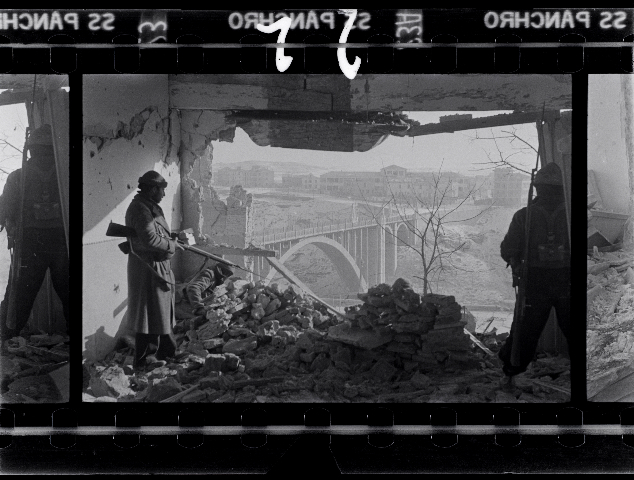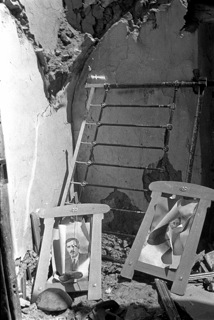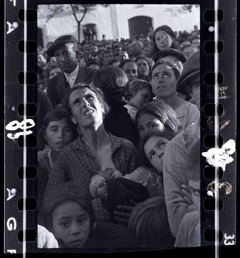
Bombing of Teruel, January 1938. Robert Capa© The Mexican Suitcase Courtesy of Magnum Photos and the International Center of Photography. The mexican Suitcase, courtesy and ©International Center of Photography, 2008.
Message in a Mexican Suitcase – Close-Ups of the Spanish Civil War
Robert Capa said that if your photograph was no good, you weren’t close enough.
In the Spanish Civil War, he and his peers got their feet wet and bloody in the war between the Spaniards who created their country’s first republic and the fascist armies who ousted them and ruled for the next four decades.

Spanish Refugees arrive at the French Internment Camp, Le Barcarés, France, March 1939. The Mexican Suitcase. Courtesy Magnum Photos and The International Center of Photography.
The Spanish Civil War was the rehearsal for Hitler’s rape of much of Europe. The bombing of the town of Guernica by German planes that Hitler provided to Francisco Franco was practice for the blitzkrieg that would follow. Bear in mind that Picasso was the director of the Prado under the Spanish Republican government. He never returned to Spain.
Picasso’s Guernica did not return to Spain until long after an elected government replaced the Franco regime. By that time, many of the fighters in the Spanish Civil War had died in exile and Picasso’s painting had become a transcendent myth on the walls of the Museum of Modern art decrying the horrors of war. If you were to ask many of its admirers what war Guernica depicted, they might not be able to tell you. There’s no doubt what the pictures in a new documentary are depicting.
The Mexican Suitcase (Director Trish Ziff, 2011, Mexico), which premiered at the Karlovy Vary International Film Festival, brings the horror that it shares with Picasso’s painting closer to the bone. The documentary takes its name from an exhibition last year that took its name from an actual suitcase containing more than 4000 photo negatives of pictures that were taken during and after the war by Robert Capa, Gerda Taro, and David “Chim” Seymour. All those photographers would die on assignment. The first to go was Taro, at age 27, in Spain.

Bombing on the Córdoba Front, June 1937. The Mexican Suitcase ©Gerda Taro, Courtesy of Magnum Photos and the International Center of Photography.
The exhibition at the International Center for Photography in New York put the actual photographs on view. In the documentary, which wasn’t finished in time for ICO, shows them on a scale that overwhelms you with the enormity of the horror of a war that took so many civilian lives. Not that other wars didn’t take such a toll– but photographers weren’t there to document so much of it so extensively.
Beyond the vivid images in The Mexican Suitcase, poignant eyewitness testimony takes you back to a defeat that installed a fascist government in Madrid. A nurse remembers treating young Gerda Taro after she’s been shot, and knowing immediately that Taro wouldn’t survive. Veterans tell of spending a viciously cold winter on beaches in France north of the border. The French gave no help to the Republican side during the war, and watched the surviving soldiers freeze and starve. Help finally came from Mexico, which took in boatloads of refugees.
Parallel to the archaeology that found and shared the photographs in The Mexican Suitcase are scenes of bodies being unearthed carefully from mass graves in Spain of more than 70 years ago. It’s a grim task, similar to that of the families of Chilean prisoners from the coup of 1973 sifting through the sands of the Atacama Desert for human remains in Patricio Guzman’s extraordinary documentary, Nostalgia for the Light.
As researchers in the film lift the dirt off bones The Spanish Civil War – a heroic fight fought by Americans of the Abraham Lincoln Brigade, but also a time of betrayal documented in George Orwell’s extraordinary Homage to Catalonia – is being reconstructed once again.

Woman breast feeds her son at a meeting for Land Reform May 1936, Extremadura, Spain. ©David"Chim" Seymour. The Mexican Suitcase 1936. Courtesy Magnum Photos, International Center of Photography, David Seymour Estate.
Curators in the film tell you that a long-kept secret is finally coming into the open. I think we’ve moved beyond that point. The world knows about Franco’s grim triumph. For a wildly grotesque take on the horror of the war that reaches down through Spanish generations, see The Last Circus by Alex de la Iglesia. Don’t forget that Pan’s Labyrinth by Guillermo Del Toro (a Mexican director then working in Spain) is set in a post-war military camp where soldiers are ordered to eliminate any lingering resistance to the Franco regime.
The Mexican Suitcase reminds you with its photographs and its archive of those images under newspaper headlines that this war was anything but a secret. Now we’re beginning to learn where the bodies are buried.
Check screening times for The Mexican Suitcase in New York and LA DocWeeks.
